Bundesliga MD 04 Preview: Leipzig against Bayern
Three games, three wins, 9-2 goals, top of the table and so perhaps the biggest rival in Bayern’s chase for the title? No, we are not talking about Borussia Dortmund. We are talking about RB Leipzig. Only a decade old and competing in their fourth Bundesliga season, Red Bull’s premier football project has already managed to gain a firm foothold in amongst the top teams of Germany’s first tier division.
With their new coach Julian Nagelsmann and a freshly revamped squad, which may arguably be as strong and deep as never before, the club from Germany’s east intends to take the next step forward on their way to the top.
Leipzig is thirsting for titles. And as big a cause of outrage the project may be with respect to its treatment of the 50+1 rule and in the eyes of many a traditional football supporter in general, its hunt for silverware is yet very real. If one sets aside all the aversion to, and criticism of, the club for a moment, RB Leipzig reveals itself as a well run club that knows to spend its money wisely. Even though the project has been built up more or less from scratch and its development has largely been fuelled by the financial power of a large international soft drink manufacturer, neither the swiftness nor the sustainability of its success is a matter of course.
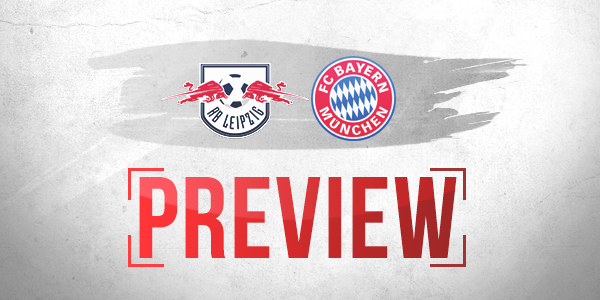
RB Leipzig: gaining a foothold at the top?
One second and third place in the league and one DFB Pokal final – even if a title has remained elusive, RB Leipzig can be fairly content with its first three years in the Bundesliga. However, the club is well aware that their own aspirations and that of their sponsor Red Bull will have to be greater in the future.
Their first goal is to reduce the distance to Dortmund step by step before they intend to become a threat to Bayern’s dominance in the middle to long term. A quick view on Leipzig’s transfer activity since they achieved promotion to the Bundesliga in 2016/17 serves to underscore the seriousness of their aims. Over this period, they have spent €257.33 million on new players whilst generating only €116.39 million from selling players. This amounts to a net spend of €140.94 million. No other Bundesliga club has such a large difference on their books.
Nevertheless, purely in terms of expenditures, Leipzig is still a ways away from Bayern (€340 million) and Dortmund (€448.94 million) over the same period. RB Leipzig’s record singing is Naby Keïta (€24 million, 2016/17 from Salzburg). Compared to Dortmund, who have signed no fewer than nine players more expensive than that over the same period, this still appears humble – not to mention a comparison with Bayern.
Taking the next step with Nagelsmann
It is part of Leipzig’s strategy to sign young and promising players full of potential at reasonable amounts. Another part of Red Bull’s strategy for Leipzig is for them to benefit from their membership in a global network of interconnected RB clubs. The most notable connection is that to Red Bull Salzburg, which has benefited Leipzig on the transfer market several times in the last years. But after Hasenhüttel’s second season at the latest, the club had to realise that clever transfers alone will not be sufficient for a subscription place at the top of the table. A disappointing sixth spot in the final table was the consequence of a lacklustre and underdeveloped game in possession.
After Ralf Rangnick successfully steered the club through his caretaker season, Julian Nagelsmann is now supposed to finally address the perceived long-standing deficiencies in Leipzig’s game. In Hoffenheim, the 32 year old managed to turn a regular relegation candidate into a serious challenger for the European places. And even though Hoffenheim probably has a greater budget than most other Bundesliga clubs, their success was generally rarher regarded as an achievement of their coach than their purse.
Nagelsmann is now briefed with replicating his Hoffenheim success at Leipzig at a higher level. He is considered the missing link that is able to turn Leipzig into a bonafide title candidate. Even if Bayern and Dortmund remain favourites, he is expected to turn Leipzig into the laughing third if the other two should stumble. Their successful start to the season will certainly not come as a hindrance to this end.
31 principles for a simply complex game
Nagelsmann is also a perfect fit for Leipzig because he always aims for the highest goals and is fairly unabashed about it. In training, he constantly strains his players to the limits of their abilities to extend and improve their skills. When he was still playing for Hoffenheim, Sandro Wagner once said: “He approaches football like a set of building blocks. I have never seen this before. He takes the complicated game of football, breaks it down into a series of phases, has us train these phases, and puts all of this together again to yield a fluid sequence.” In an answer to the question if he sometimes felt lost amidst the frequent tactical changes Nagelsmann makes during a match he said: “No. That’s why we do all the practicing after all.”
Perhaps Wagner’s statement serves as the perfect summary of both Nagelsmann’s greatest asset and the biggest misunderstanding about him. On the one hand, he is someone who is always willing to learn and improve his skills, a readiness he also expects of his players. In a sense, he is a nerd who pays attention to the smallest details. On the other hand, he also has substantial social and man management skills. He once said that he estimated a team’s tactical capability as constituting between 35 to 40% of its performance level. The rest, he says, is a result of good man management. Nagelsmann does not just say this, he in fact seems to be the very rare example of a coach who is able to convey complex topics in a way that is relatable and understandable to his players. And it is this his dual skill that allows his teams to flourish and excel. They are able to seamlessly switch between several tactical systems resting assured that their coach trusts in their capability to do so and will not break their necks after every simple mistake.
Although the season has just begun, Nagelsmann’s has already had a perceptible impact at Leipzig. While he was still at Hoffenheim, he once said that his idea of football rested on 31 principles that should act as a guideline for his players to aid them in implementing his ideas. Among other things, Nagelsmann wants his players to avoid one-on-one duels if possible. Instead, he wants his players to force their opponents to play missed passes because he believes one-on-one duels to be too susceptible to chance. He also wants his players to initiate their possession game with their ball winning touch. A condition that will require a lot of concentration from Bayern. Not every ostensibly unmarked space is an invitation that should be accepted. Nagelsmann is a diligent planner who likes to set pressing traps.
Nagelsmann’s diamonds
Another one of Nagelsmann’s key principles is the principle of width. He wants his teams to make the game as wide as possible but not any wider. Early signs of this principle at work are already apparent at Leipzig. Nagelsmann prefers his teams to build up through the centre and central half spaces. For this he needs a tight formation. Thus, Nagelsmann’s teams are often sparsely populated on the wings. Most players are located in the central areas of the pitch. Nagelsmann favours tight diamonds in build-up play as the example from the game against Frankfurt shows. Here too the principle helps, because it makes it possible to reduce the distances between the players in gegenpressing without causing them to stand on each other’s toes.
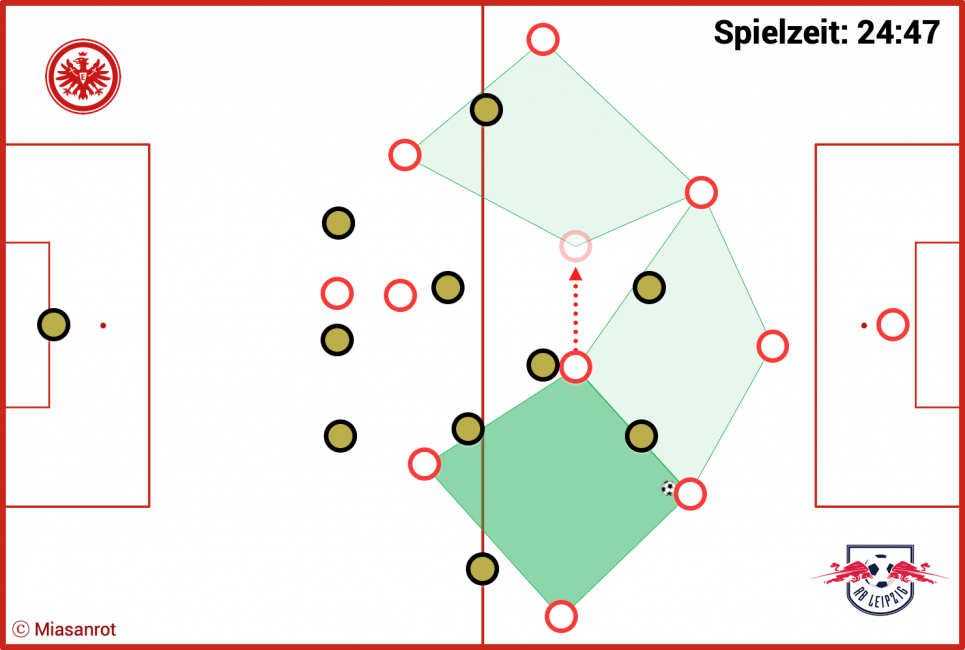
These diamonds help the players to execute another one of Nagelsmann’s principles: the principle of playing the ball diagonally instead of horizontally or vertically because he believes this to be more difficult to defend and allowing his team to play in more interesting spaces. Players interacting in diamonds also lead to more situations of superior numbers facilitating an effective build-up play from the back.
Due to their 1-2 formation in attack (compare the graphic above) and an ineffective involvement of Leipzig’s two number eights, Frankfurt managed to repeatedly and decisively interrupt Leipzig’s offensive game. The two forwards aptly switched back and forth between man marking the centre-backs and occupying the passing lanes of the number eights whenever they fell back. Moreover, in midfield Daichi Kamada could take his direct opponent Diego Demme mostly out of the game. Leipzig therefore never quite got control of the game and continually had problems to get their attacking duo of Yussuf Poulsen and Timo Werner involved. If Nagelsmann relies on his 3-1-4-2 formation again, Bayern could learn from Frankfurt and adopt their tactic of having their wingers keep Leipzig’s centre-backs busy while one of their number eights takes care of Leipzig’s holding midfielder. The remaining two midfielders in Bayern’s 4-1-4-1 would be tasked with blocking Leipzig’s aforementioned diagonal passing lanes.
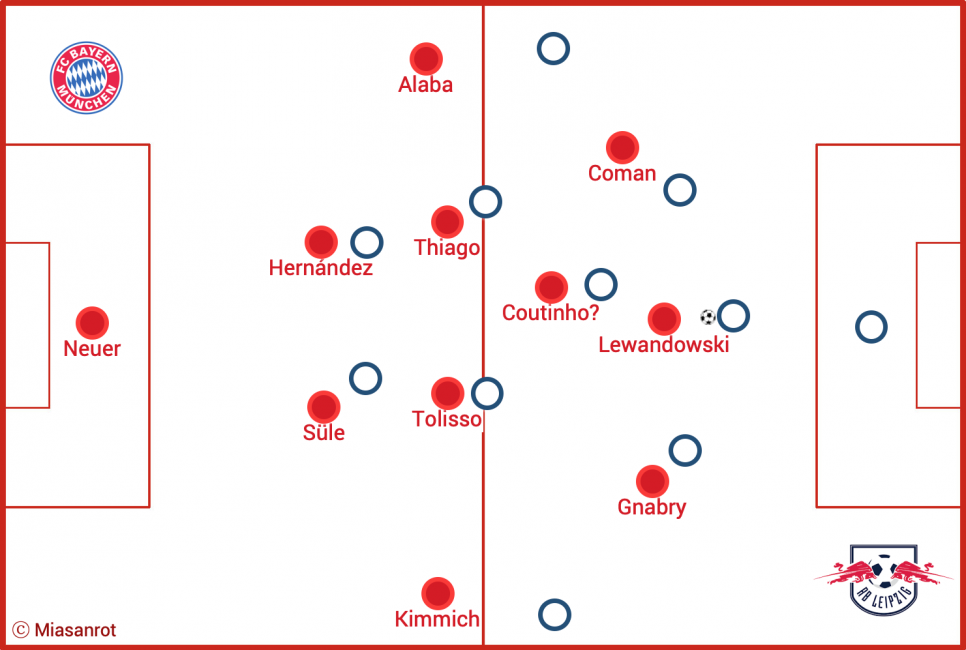
Bayern applied similar mechanisms against Nagelsmann’s kind of football in the match against Hoffenheim at the beginning of the calendar year. An effort that was met with success for at least one half. The high, man-oriented pressing in the centre forced Hoffenheim to often play the chipped ball out to their wing-backs, who were promptly attacked by three Bayern players at once. Bayern also applied the same kind of pressing traps in the match against Hertha.
Leipzig against Bayern: the road to victory leads through midfield
Leipzig delivered a more consistent level of build-up play in their two games against Union Berlin and Gladbach than in the game against Frankfurt. Especially good looking was the way they occupied the half spaces and presented the typical Nagelsmann zig zag pattern in carrying the ball forward. It was also noticeable how they used their pressing more cautiously and only in spells. Whenever they drew back on their former all out gegenpressing, large gaps between midfield and attack tended to appear.
It will hence be intriguing to observe how tightly organised Leipzig can keep their defensive lines against Bayern. Bayern’s two matches against Hertha and Mainz showed that they know how to graciously accept the gifts they are offered in the half spaces. On the other hand, they have problems if the opponent closes down the middle and keeps the defensive centre crowded.
On the whole, Nagelsmann could do worse than sticking to his customary 3-1-4-2 formation and instruct his team to launch its pressing high up the pitch. This would allow his team to counter the usual mechanisms in Bayern’s game both in the centre and on the wings. In so doing, the key to their success lies in the centre of midfield.
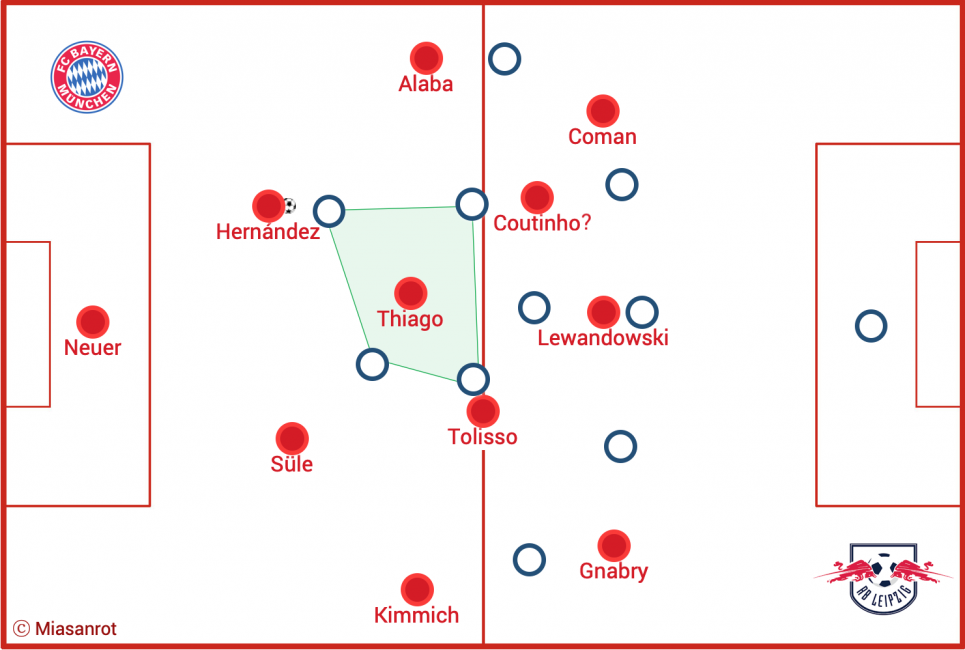
It will be crucial for both teams to what extent Bayern will be able to involve Thiago in the game. If they succeed in this, it will be important for Leipzig’s front four in their 3-1-4-2 to keep a proper balance between man marking and zonal marking in pressing. Thiago’s passing options and his general availability as a playmaker would have to be contained by suitable countermeasures in pressing. The same holds true if Leipzig elects to play in the 4-4-2 they used against Gladbach, with the added complexity in this case that their holding midfielders have to be extra careful in keeping the gaps to their midfield to a minimum.
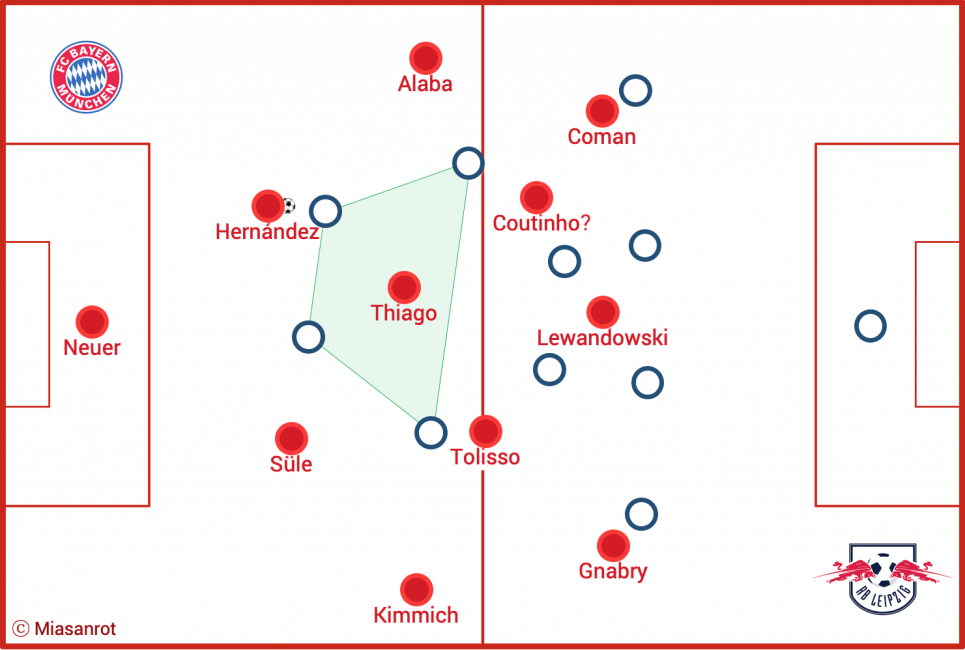
Bayern on the other hand has to prevent Leipzig from isolating Thiago. One way to do this is for their two number eights to reduce their hitherto unacceptable distances to their defensive line. Alternatively, their full-backs could move in momentarily to add additional bodies to the centre. At any rate, Thiago should not be compelled to fall back in between the centre-backs as this would completely take him out of the game as a transition player relaying the ball forward.
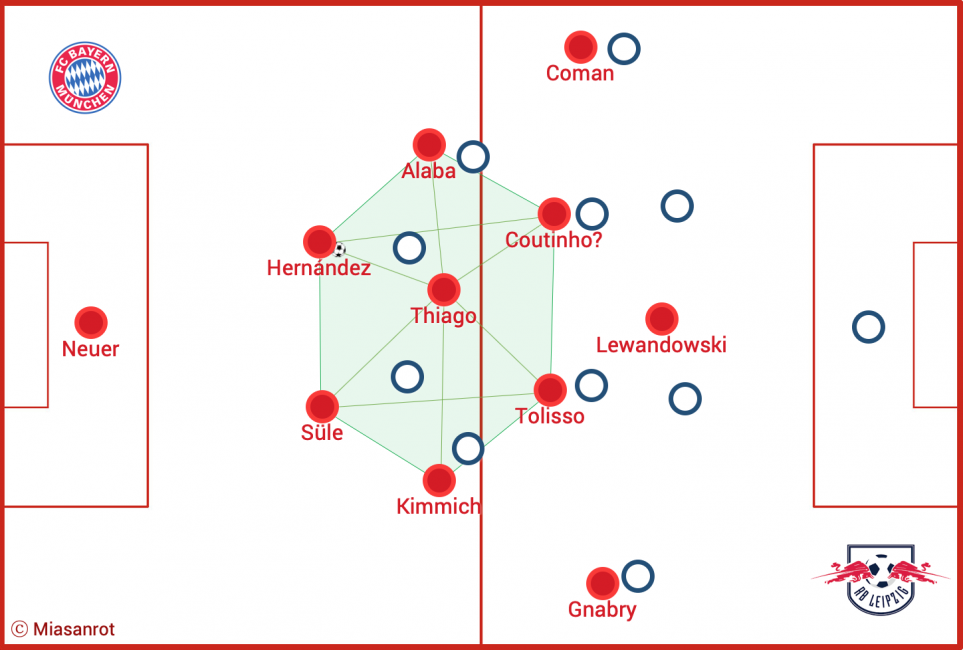
This graphic shows why Leipzig could be better off starting in a 4-4-2 formation. If Alaba and Kimmich stick to the wings (which seems likely), they would enjoy a 6 against 5 superiority in the centre. Their customary 3-1-4-2 would not afford them this advantage. In either case, Bayern would be wise to draw in their full-backs and have their number eights drop off to fill the centre when necessary. This would also force Leipzig to make quick decisions: how far up the pitch do we position our full-backs when Coman and Gnabry decide to fall back? What do we do if Bayern’s wingers constantly stay high and try to tie our full-backs up deep in our own half instead? And how do we position our midfielders if Bayern keeps the centre tightly organised? Every sudden either or question adds stress to Leipzig’s on-pitch decision making and helps destabilise them. Holes might occur, spaces might appear. But Bayern must not surrender the ball carelessly if they are to make best use of such occasions.
There is another opportunity for Bayern to avail themselves of that they could mimic from Manchester City: more consistently involving Manuel Neuer in building up from the back. It is striking how absent he is from Bayern’s game whenever the balance of play lies in the opponent’s half (as it so often does). If he were more often used as an additional outfield player, he could play a considerable role in Bayern’s build-up beyond simple long balls and short passes to the defenders ahead of him.

The graphic is meant to depict a potential situation of Bayern overloading the half spaces. Leipzig’s players are asked questions: do they also shift their players to the right to equalise the 5 against 4 disadvantage, thus opening up room for Kimmich (for example) on the other wing? Or do they accept to be outnumbered on the right wing? Bayern is quite careless in wasting the resource of Manuel Neuer as a proper outfield player, especially in light of the fact that it was he who revolutionised the goalkeeper’s game in this respect.
Benchmark for both teams
Bayern is not the only team that has started the season with difficulties to control a game for the whole 90 minutes. Leipzig had such problems too, but in Frankfurt and Gladbach they have already faced two teams who finished seventh and fifth last season. Hertha (11th), Schalke (14th), and Mainz (12th) cannot lay a similar claim. Whereas RB Leipzig has gathered all nine available points so far, Bayern did not manage a win against Hertha for sheer inaptitude.
The contest on Saturday may therefore be a bigger yardstick for the German record champions than for Nagelsmann’s team. Leipzig has come out of their early season challenges unscathed. But for them too the game against Bayern on Saturday will doubtless be their sternest test yet. Their knowledge that they could pull away by five points already if they win will do nothing to soothe the pressure.
It will become really clear for the first time this season if Leipzig’s level of performance is equal to their ambitions. Although Nagelsmann’s new ideas will certainly still take time to fully take root, his team yet seems to be adapting well to his changes. Bayern may welcome an early test against Leipzig for two reasons: first, a strong contender like Leipzig will brutally reveal their deficiencies in midfield and offence and be a realistic benchmark for the quality of their pressing. Second, it stands to reason that Leipzig will only grow stronger the longer the season takes. In a few weeks, they would be an even more uncomfortable opponent – especially away.
Three games, three wins, 9-2 goals, top of the table, and thus perhaps the biggest rival in Bayern’s chase for the title? Come Saturday, Leipzig has the chance to substitute the question mark for an exclamation point. But how difficult an opponent Bayern is to play against, they do not least know from last season’s DFB Pokal final. And besides all the tactical nuances that will determine Saturday’s match, Bayern have a very special quality to suddenly raise their game cometh the hour. And it is this what makes the first real top fixture of the season all that exciting.









